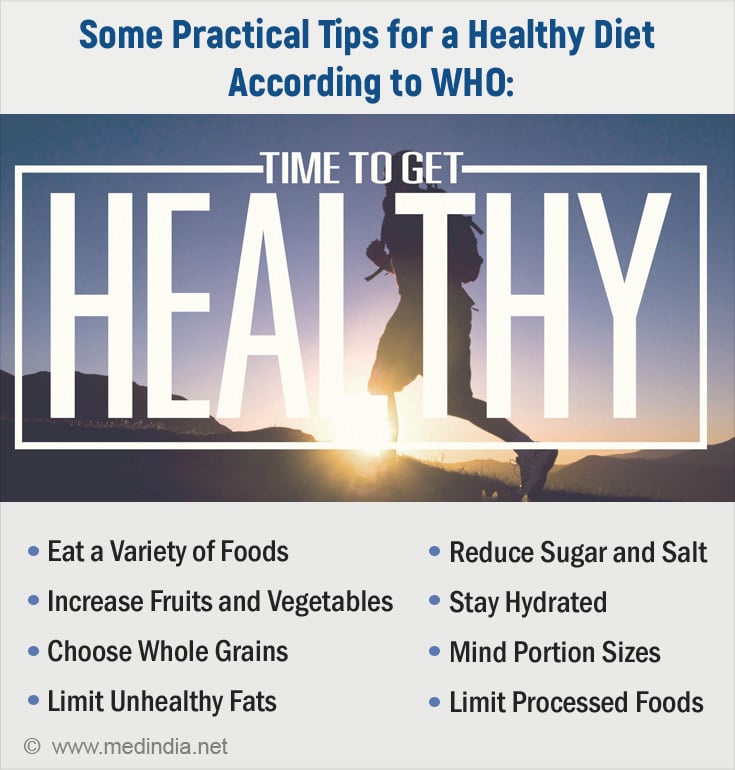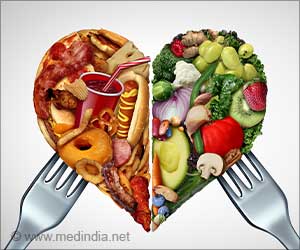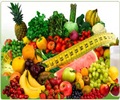- Healthy diet - (https://www.who.int/news-room/fact-sheets/detail/healthy-diet#)
About
Malnutrition and noncommunicable diseases (NCDs) can be prevented through healthy eating habits, hence it is important for people to have good healthy diet. The World Health Organization WHO has a set of recommendations on how clients should eat in order to have a healthy diet regardless of their age(1✔ ✔Trusted Source
Healthy diet
Go to source).
Did You Know?
A balanced diet can reduce the risk of chronic diseases by up to 80%! #healthychoices #balanceddiet #medindia
Importance of a Healthy Diet
A healthy diet is important for a variety of reasons.
Prevention of Malnutrition: It aids in the prevention of many types of nutritional deficiencies by delivering the necessary nutrients for human body growth.
Reduction of Noncommunicable Diseases (NCDs): Well balanced diet is important in order to reduce the incidence of NCDs such as diabetes, heart disease, stroke and some forms of cancer.
Support for Healthy Growth: Proper nutrition providedin a balanced diet that children especially those in the growing ages are fedleads to their healthy growth and good performance in future.
Energy Balance: A healthy diet helps in regulation of energy and will not contribute to overeating or obesity.
Improved Quality of Life: Diet enhances the lives, as well the physique and mental state of an individual.
Key Components of a Healthy Diet
1. Balance Energy Intake
Energy Balance: Calories consumed should equal calorie expenditure in order to avoid obesity.
Fat Intake: The total fat density should not exceed 30% of total energy density, and saturated fats should amount to less than 10% of total energy density; trans-fats should be less than 1% of total energy density.
2. Recommended Nutrient Intake
At least 400 grams of fruits and vegetables should be consumed.
Free sugars should not account for more than 10% of total daily energy intake, and only 5% for added health benefits.
To avoid high blood pressure, heart disease, and stroke, adults should take no more than 2 grams of sodium per day, or 5 grams of salt or less.

Dietary Guidelines for Adults
Essential Food Groups
1. Fruits and Vegetables
Health practitioners advise that people, especially the adults, require 400 grams, or five portions of fruits and vegetables a day.This does not include starchy roots like potatoes, sweet potatoes and cassava and the rest.
Benefits: A diet rich in fruits and vegetables can help decrease NCDs risk and supplies vitamins, minerals and dietary fiber.
2. Whole Grains
This should comprise unfinished whole grain foods like oats, brown rice, unprocessed maize, millet, as well as whole wheat.
Benefits: Whole grains contain fiber which assists in digestion, and help prevent weight gain.
3. Legumes and Nuts
Include as many kinds of pulses as possible such as lentils and beans, and nuts in different meals of the day.
Benefits: The following are good examples of foods that leave you full, rich in protein, healthy fats and nutrients.
4. Healthy Fats
It is recommendable that one focuses on the unsaturated fats common in fish, avocados, nuts and olive oil.
Limitations:
- The total fat content should not exceed 30 percent of total energy content.
- Trans fats should not be more than 5% while saturated fats should not exceed 10% of the total Energy Percentage.
- The amount of intake of trans-fats should not exceed one percent of the total energy, better still one should avoid the use of industrially produced trans-fats.
Practical Tips for Adults
1. Eat More Fruits and Vegetables
- It is advisable to prepare meals with vegetables in order to increase the nutritional value of the served meals.
- Try to consume fruits, and raw vegetables as they are healthy for consumption.
- One should try to select fruits and vegetables that are seasonal in order to select more varieties of fresh ones.
2. Limit Unhealthy Fats
Cooking Methods: Avoid deep frying your foods instead try to bake, steam and boil among other methods of preparing your foods.
Fat Substitutes: Replace the use of butter, lard, and ghee into oils high in polyunsaturated fats including soybean, canola, corn, safflower and sunflower oils.
Meat Choices: Excellent sources of lean protein include low-fat meats and poultry and low-fat dairy products, which should be prepared with little or no addition of fats.
3. Reduce Salt and Sugar Intake
Salt Consumption: Although it is recommended that consumers should take a small amount of salt per day which is approximately 5grams, the ideal portion size of salt for the consumer is less than 2 grams.
High-Sodium Foods: Avoid using excessive amounts of soy sauce or fish sauce etc, and foods that contain high salt, such as packaged foods.
Sugar Intake: Free sugars should constitute not more than 10% of total energy intake, although the recommended level is less than 5% to gain the benefits. This refers to free sugars found in baked goods, candies, soda, and energy drinks, as opposed to sugars found naturally in honey, syrups, and fruits.
Dietary Guidelines for Infants and Young Children
1. Breastfeeding: Breast milk should be exclusively provided to neonates up to six months of age, following calendar time. This is why no other foods or liquids including water should be taken for these periods of time.
Continued Breastfeeding: At six months, breastfeeding should be continued with complementary foods for at least two years or more of age for the child. This helps to enable an infant to take essential nutrients as well as antibodies that strengthen their immune system.
2. Complementary Foods
Introduction of Solid Foods: When the baby is six months of age, breast milk should be supplemented with adequate, safe and age-appropriate foods. This transition is crucial especially in order to address the increasing demands for nutritional changes that are required in infants.
Nutrient-Dense Options: The complementary foods should be a variety of fruits, vegetables, grains and proteins in order to supply the body with necessary vitamins and minerals.
Avoid Added Salt and Sugars: The complementary foods should never be fortified with Use of salt and sugars. In this way, the child does not get accustomed to some type of palate mainly of salty and sweet products which are dangerous as the child will grow up.
Tips for Feeding Infants and Young Children
1. Diverse Diet
Variety of foods: Feed infants and young children a variety of foods to ensure that they consume adequate portions. This consists of all natural foods, including fruits, vegetables, grains, and protein sources such as beans and lean meat.
Texture Progression: Incorporate thicker texture into their diets as the child progresses in his age set gradually from one texture food to another that requires chewing and swallowing.
2. Responsive Feeding
Recognizing Hunger Cues: The caregivers should observe the baby and should not force feeding unto the baby since the baby should eat as much as he or she desires.
Encouraging Self-Feeding: Self-feeding should be promoted as a child grows in order to enhance skills in use of hands during food handling.
3. Healthy Eating Environment
Positive Mealtime Atmosphere: Develop a pleasant and a relaxed eating atmosphere to influence the meals consumption pattern. Specific goals include no use of screens during the mealtime.
Family Meals: Whenever possible children under five years of age should be encouraged to sit at the family table during meal times to encourage socialization and to allow them taste different foods.
The WHO considers the consumption of a balanced diet to help in combating malnutrition and non communicable diseases. Foods are also divided into five food groups which help in guiding those that want to know how to eat healthy; thus making healthy eating choices can lead to better health among people, thereby, forcing a healthier society.









